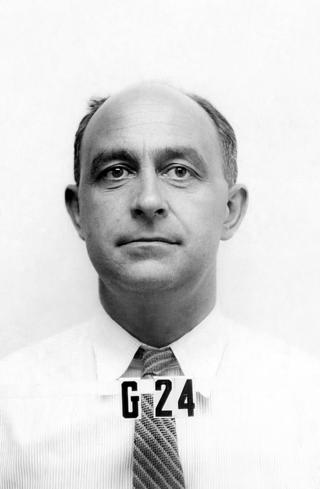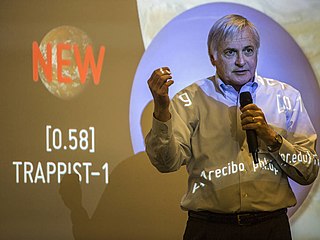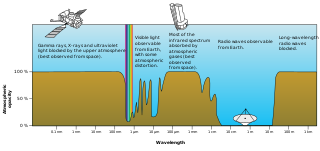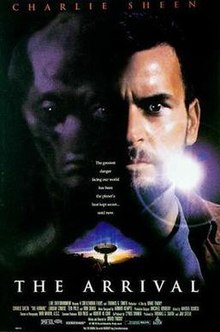
The Fermi paradox is the discrepancy between the lack of conclusive evidence of advanced extraterrestrial life and the apparently high likelihood of its existence. As a 2015 article put it, "If life is so easy, someone from somewhere must have come calling by now."
The search for extraterrestrial intelligence (SETI) is a collective term for scientific searches for intelligent extraterrestrial life, for example, monitoring electromagnetic radiation for signs of transmissions from civilizations on other planets.

Frank Donald Drake was an American astrophysicist and astrobiologist.

Contact is a 1985 hard science fiction novel by American scientist Carl Sagan. It deals with the theme of contact between humanity and a more technologically advanced extraterrestrial life form. It ranked No. 7 on the 1985 U.S. bestseller list. The only full work of fiction published by Sagan, the novel originated as a screenplay by Sagan and Ann Druyan in 1979; when development of the film stalled, Sagan decided to convert the stalled film into a novel. The film concept was subsequently revived and eventually released in 1997 as the film Contact starring Jodie Foster.
Extraterrestrial intelligence (ETI), a subset of non-human intelligence (NHI), refers to hypothetical intelligent extraterrestrial life. No such life has ever been proven to exist in the Solar System except for humans on Earth, and its existence in other star systems is still speculative. The question of whether other inhabited worlds might exist has been debated since ancient times. The modern form of the concept emerged when the Copernican Revolution demonstrated that the Earth was a planet revolving around the Sun, and other planets were, conversely, other worlds. The question of whether other inhabited planets or moons exist was a natural consequence of this new understanding. It has become one of the most speculative questions in science and is a central theme of science fiction and popular culture.

The SETI Institute is a not-for-profit research organization incorporated in 1984 whose mission is to explore, understand, and explain the origin and nature of life in the universe, and to use this knowledge to inspire and guide present and future generations, sharing knowledge with the public, the press, and the government. SETI stands for the "search for extraterrestrial intelligence".

Seth Shostak is an American astronomer and author, and is currently the senior astronomer for the SETI Institute.

The Wow! signal was a strong narrowband radio signal detected on August 15, 1977, by Ohio State University's Big Ear radio telescope in the United States, then used to support the search for extraterrestrial intelligence. The signal appeared to come from the direction of the constellation Sagittarius and bore expected hallmarks of extraterrestrial origin.

The Allen Telescope Array (ATA), formerly known as the One Hectare Telescope (1hT), is a radio telescope array dedicated to astronomical observations and a simultaneous search for extraterrestrial intelligence (SETI). The array is situated at the Hat Creek Radio Observatory in Shasta County, 290 miles (470 km) northeast of San Francisco, California.

Arrival II, alternatively titled The Second Arrival, is a 1998 American science fiction direct-to-video film directed by Kevin S. Tenney. The film is a sequel to the 1996 film The Arrival. It was written by Mark David Perry and based on characters created by David Twohy. The film stars Patrick Muldoon, Michael Sarrazin, Jane Sibbett, Catherine Blythe, Michael Scherer, and Larry Day.

The waterhole, or water hole, is an especially quiet band of the electromagnetic spectrum between 1420 and 1662 megahertz, corresponding to wavelengths of 21 and 18 centimeters, respectively. It is a popular observing frequency used by radio telescopes in radio astronomy.

H. Paul Shuch is an American scientist and engineer who has coordinated radio amateurs to help in the search for extraterrestrial intelligence (SETI).
Active SETI is the attempt to send messages to intelligent extraterrestrial life. Active SETI messages are predominantly sent in the form of radio signals. Physical messages like that of the Pioneer plaque may also be considered an active SETI message. Active SETI is also known as METI.
The cultural impact of extraterrestrial contact is the corpus of changes to terrestrial science, technology, religion, politics, and ecosystems resulting from contact with an extraterrestrial civilization. This concept is closely related to the search for extraterrestrial intelligence (SETI), which attempts to locate intelligent life as opposed to analyzing the implications of contact with that life.

Lone Signal was a crowdfunded active SETI project designed to send interstellar messages from Earth to a possible extraterrestrial civilization. Founded by businessman Pierre Fabre and supported by several entrepreneurs, Lone Signal was based at the Jamesburg Earth Station in Carmel, California.

Breakthrough Listen is a project to search for intelligent extraterrestrial communications in the Universe. With $100 million in funding and thousands of hours of dedicated telescope time on state-of-the-art facilities, it is the most comprehensive search for alien communications to date. The project began in January 2016, and is expected to continue for 10 years. It is a component of Yuri Milner's Breakthrough Initiatives program. The science program for Breakthrough Listen is based at Berkeley SETI Research Center, located in the Astronomy Department at the University of California, Berkeley.

The Berkeley SETI Research Center (BSRC) conducts experiments searching for optical and electromagnetic transmissions from intelligent extraterrestrial civilizations. The center is based at the University of California, Berkeley.
Eric Korpela is a research astronomer at the University of California, Berkeley, He is the director of the SETI@home project, a distributed computing project that was launched in 1999 to use individuals computers to analyze data collected in the Search for Extraterrestrial Intelligence (SETI). Korpela notes that with modern-day mobile devices having greater capacities than personal computers did in 1999, SETI@home has developed an Android app to analyze data gathered by the Breakthrough Listen SETI project.

BLC1 was a candidate SETI radio signal detected and observed during April and May 2019, and first reported on 18 December 2020, spatially coincident with the direction of the Solar System's closest star, Proxima Centauri.

The following outline is provided as an overview of and topical guide to extraterrestrial life:















